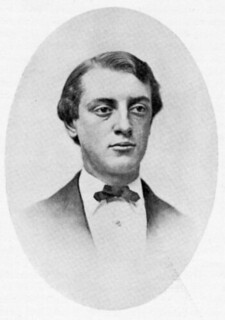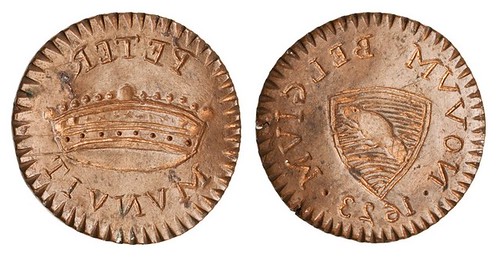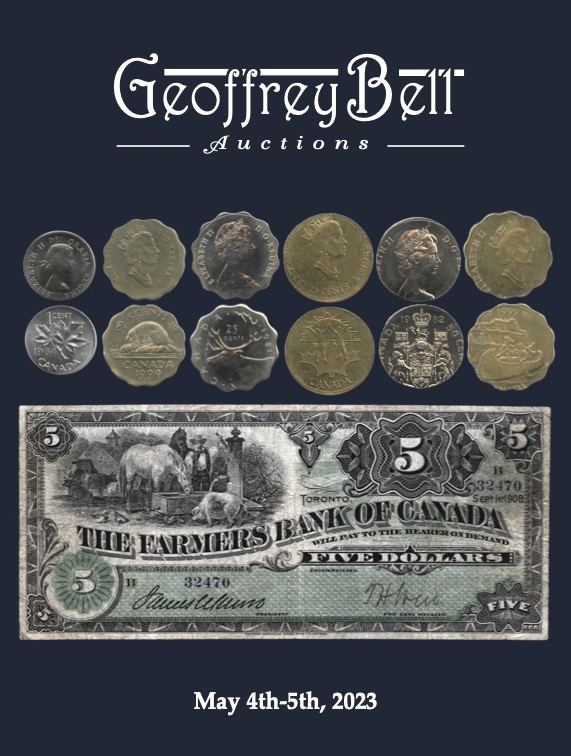
PREV ARTICLE
NEXT ARTICLE
FULL ISSUE
PREV FULL ISSUE
CHARLES WYLLYS BETTS – THE FIRST 20 YEARSE-Sylum Feature Writer and American Numismatic Biographies author Pete Smith submitted this article on C. Wyllys Betts. Thanks! Pictured below are Betts and the die for the Novum Belgium piece (with its lettering and images in reverse). -Editor
Charles Wyllys Betts – The First Twenty Years
Charles Wyllys Betts was born at Newburg on the Hudson, New York, on August 13, 1845. His father was Judge Frederick Joel Betts (1802-1879). His mother was Mary Ward Scoville (1812-1868). Judge Betts moved the family to New Haven, Connecticut, in 1855 so his sons could be educated at Yale. Mary Ward Scoville had a common ancestor about five generations back with James Mitchell Lawson Scovill and William Henry Scovill, who started the company that became Scovill Manufacturing, makers of transportation tokens and coin blanks for the U.S. Mint. However, the connection is too distant to be worth including here. Charles was taken out of school with health issues and was home-schooled. He took up coin collecting for recreation and searched for old coins that might be found around New Haven. In 1860 he began to experiment with die engraving and primitive methods for striking coins. His 1860 sale of duplicates made him a coin dealer and he produced crude storecards with his name. In 1862 he received a set of letter punches and better engraving tools. Many of his productions were unique. His early interest in numismatics ended when he entered Yale College in 1863. An auction was catalogued by Woodward and sold by George Leavitt on May 17, 1864, with the title Collection of C. Wyllys Betts, of New Haven, To be sold at Public auction as Addenda to the Collection of W. Elliott Woodward. The title was followed with Note. – Very many of the pieces here offered, are struck from excessively rare dies, recently engraved, all of which are destroyed, and every piece being the best in existence. It is the sincere wish of the owner that they meet with satisfaction, This was then followed with the title Fabrications, Struck Copies, &c. and then a listing of 22 pieces. The catalog identified that these were fabrications, recently made, from the collection of Betts. There was no intention to defraud the buyers. In his house organ, Numisma for November 1877, Eduard Frossard announced the discovery of an important colonial coin shown to him by Captain William Defendorf on September 19, 1877. He described it as: Obverse. Earl's crown, PETER MINVIT, Reverse, Triangular shield with slightly curving border, and beaver in field of rippling waters, NOVVM BELGIVM 1623; border serrated, size 18. Frossard did extensive research and declared it to be a genuine piece for New Netherlands. He acknowledged the possibility our theory must be accredited as correct, unless, indeed, the very spirit of cunning and deceit assisted by the utmost mechanical skill presided at its birth in a modern attelier de faussaire! Frossard did not mention that this piece was number 8 from the 1864 Betts sale. J. W. Scott was quick to point out the truth in the December 1877 issue of his Coin Collectors Journal. He wrote, A young gentleman, finding time hang heavily on his hands, amused himself by engraving dies in imitation of rare coins; afterward he branched out and designed some altogether fictitious … Scott and other critics took the opportunity to mock Frossard for being duped by an obvious and easily identified fabrication. (The entire article is amusing and worthy of reading.) In the March 1877 issue of Numisma, Frossard admitted that he had been in error. The same documents Frossard used to authenticate the piece had been used to inspire its fabrication. He included a letter from the creator but did not name him. An excerpt from the Numisma article was included in The Numismatist article mentioned previously. The dies were cut upon coins of the halfpenny size, either worn smooth or filed away on one side. My only tools were an awl for cutting the letters and the outlines of the figures, and a knife for gouging out the broader parts of the designs. When the cutting was finished each die was heated white hot and dipped into cold water. A third smooth copper of the halfpenny size was then heated and placed between the dies, and the three, being quickly rolled together in a sheet of lead, from a tea box, to prevent them from slipping, were pounded upon an anvil with a six pound dumb-bell. The heating process gave an air of antiquity to the pieces. C. Wyllys Betts admitted production of such fantasy pieces between the ages of fifteen and eighteen. They were done more for his amusement than from any intent to profit from his deception. Betts dies that had not been destroyed prior to the 1864 auction, were later given to Yale College. They have since disappeared, possibly during the May 29, 1965, unsolved theft from the Yale library. The American Numismatic Society in New York has a number of the Betts dies including those for the Novum Belgium piece. These were donated by Frederick C. C. Boyd. This story, with copies of the relevant documents, was told by Don Taxay in his 1963 book, Counterfeit Mis-Struck and Unofficial U. S. Coins on pages 139 through 147. As this is still covered under the original copyright, it will not be found on the Newman Numismatic Portal. Readers would be required to pick up the actual physical object and turn through the pages. The story started with Betts but became the story of the commentary and bickering among the prominent dealers of their time, Frossard, Mason, Scott and Woodward. If the Betts story ended there, his fabrications would probably be ignored as the amusements of an idle teenager. What he did in the last twenty years of his life is still topical and relevant in 2023. Perhaps that story will be in The E-Sylum next week. We'll look forward to part two! -Editor
Wayne Homren, Editor The Numismatic Bibliomania Society is a non-profit organization promoting numismatic literature. See our web site at coinbooks.org. To submit items for publication in The E-Sylum, write to the Editor at this address: whomren@gmail.com To subscribe go to: https://my.binhost.com/lists/listinfo/esylum All Rights Reserved. NBS Home Page Contact the NBS webmaster 
|


